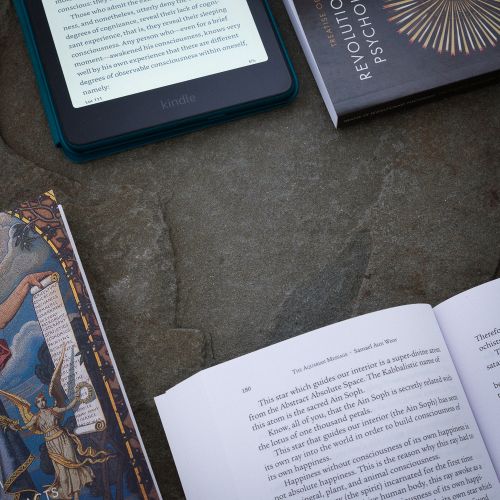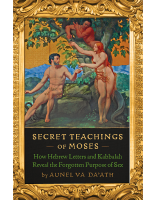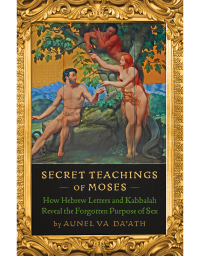The Garden of Eden has two main trees:
- The Tree of Life: Kabbalah
- The Tree of Knowledge: Alchemy
The Tree of Life comprises all of the parts of the Being manifested in the universe. The Tree of Knowledge is the sexual force of Jah-Havah Elohim: Binah.
We study the Being through Kabbalah. We study the sexual force of the Holy Spirit through Alchemy.
The Garden of Eden unites the two trees. Eden is the only place in the Bible where we find that the Tree of Life and the Tree of Knowledge are together. Therefore, Eden encloses the mystery of these two trees.
It is important to understand that there are two types of Eden. That is, there are two gardens of Eden:
- The Garden of Eden above, which is in the “hidden” Sephirah Daath דעת in the Tree of Life. It is also called Sarah.
- The Garden of Eden below, which is the Sephirah Yesod יסוד: the vital, ethereal body, in the Tree of Life. It is also called Hagar/Agar הגר, Mitzrayim מצרים, or Egypt.
This is how we must understand Genesis. Without this important comprehension, we fall into error and confusion.
The first Garden of Eden we will speak about is the Garden of Eden above. It is described in the second chapter of Genesis:
Every plant of the field before it was in the earth, and every herb of the field before it grew: for Jehovah Elohim [the Holy Spirit] had not caused it to rain upon the earth. —Genesis 2:5
This rain is the water from Shamayim שמים, because “rain” implies water. When that water is not on the earth it means that the Holy Spirit (Binah) is not yet impregnating the mother earth. It has not impregnated that Eden or chaotic matter within the chaos of Daath. But every archetype is there in the chaos and is preparing to be developed.
The Edenic earth, the Mother, is God’s feminine aspect. This is what we call Chavah (Eve), or the Nukvah נקבה, the feminine aspect of the Holy Spirit. This is why we state that the union of the masculine and the feminine aspects of the Holy Spirit relates to the Sephirah Daath; those aspects are hidden in the word Jehovah יהוה (Jah-Havah or Iod-Havah). Jah יה is masculine and feminine, and Havah הוה “to become” or Eve, is also feminine (within which everything becomes). So, Jah-Havah is sometimes called Adam Kadmon אדם קדמון, the two superior creative forces of Binah hidden in the trinity, since Adam מדא is made from Adamah אדמה, the feminine aspect or the ground (Eden).
The next verse says:
But there went up a mist from the earth, and watered the whole face of the ground. —Genesis 2:6
That mist (Od אד in Hebrew) from the earth is the feminine sexual energy of the Mother (Am אם in Hebrew) that ascends in order to water the earth that is her own body, since the Divine Mother is the feminine aspect of Binah, the Holy Spirit. She has the power of creation. She has in her womb all the seeds (the archetypes of Atziluth) of the universe, thus, to in order generate, to create, she needs the rain from the Holy Spirit. That rain is the fiery water that comes from above:
“...for Jehovah Elohim had not caused it to rain upon the earth (the woman).”
Any woman has creative potential in her womb, yet if she wants to create a baby, she needs a man “to rain” for her, to fertilize her earth. She needs a man to place his sperm in her womb, in order for her womb to be sowed with life. She cannot create by herself, just as a man cannot create alone. Thus, Genesis 2:6 is a sexual, alchemical teaching. This is why after this verse it is written:
And Jehovah Elohim formed Adam of the dust [the archetypes] of [Adamah] the ground, and breathed into his nostrils [the Neshamah] the breath of life [the breath of Chavah – “because she was the mother of all living”]; and Adam became a living soul. —Genesis 2:6
The formation (Yetzirah יצירה) of Adam1 is comprised of a long process of alchemical initiations. When writing this scripture, Moses hid the long alchemical process within very simple, yet esoteric, alchemical and kabbalistic symbols.
The Holy Spirit forms Adam from the dust of the ground, meaning the archetypes from the ground, which are in the mist (Od אד) of Adamah; that is, the mist of Mem מ (water), in the Hei ה , the yoni) of Ha’aretz הארץ, the earth. Adamah and Ha’aretz mean the same thing: the feminine aspect. In other words, the Holy Spirit makes Adam from Od אד, the mist, the elements that the Mother has in her womb.
This is very simple to understand when we look to our own level. The woman has all the elements in order to create a baby, but she needs the man to impregnate her in order to form (Yetzirah יצירה, formation) a child from the dust, from those elements, from those atoms that she has in her womb in an archetypal manner, without form. If you look inside the womb of any woman, you will find there all the elements that are needed in order to create a physical body. Yet, they are “empty and without form.” When we place the sperm within the ovum of that woman, then the elements start working and taking shape. Therefore, Jehovah Elohim needs to cause “rain” upon that ovum, that Adamah or that earth. Thereafter, the woman forms or flourishes and blooms with pregnancy for nine months. She is the one that is forming the child, but she needed the seed of a man. Thus, this is how the earth blooms. This is how we understand Genesis in its alchemical aspect.
Jehovah Elohim has both a masculine and feminine aspect within. In other words, in the sexual act, Jah יה, Father-Mother, must be united so that they can become “Havah,” an Elohim, in order to form Adam אדם from Adamah אדמה, or Ha’aretz, the earth.
As above so below, and as below so above.
Binah, the Holy Spirit, creates through our bodies. Unfortunately, right now it is done through fornication, because animals fornicate. But above, in Briah, there is no fornication. In Briah, we see that God impregnates the chaotic matter with Shin ש (fire), and then the earth becomes filled with life. This is how we have to understand alchemically and alchemically the first chapter of the book of Genesis where this is explained in more detail. Only by walking on the path of initiation can we understand this better.
Sequentially, it is written that Jehovah Elohim breathed into Adam’s nostrils “the breath of life.” In Hebrew, breath is Neshamah נשמה, which also means “soul.” The work of instilling the Neshamah נשמה, or the breath of life, into the body of Adam, is a very long process, which is spoken about in many different books of initiatic esotericism.
Thereafter it is written:
And Iod-Havah Elohim planted a garden eastward in Eden; and there he put the man whom he had formed. – Genesis 2:8
In other words, in Eden, Iod-Havah Elohim יהוה אלהים placed Adam, whom he had formed in the world of Yetzirah.
When it is written that Jah-Havah Elohim planted a garden eastward in Eden, we have to understand that this refers to the Sephirah Tiphereth, because esoterically speaking, kabbalistically speaking, Tiphereth is “the East” on the Tree of Life עצ חיים. Thus, this first garden is not the physical, tri-dimensional Earth, because the Sephirah Malkuth, which represents the three dimensional universe, macro and microcosmically, is “the West,” esoterically speaking. Therefore, “eastward in Eden” refers to the upper Eden, the Sephirah Daath, which is precisely where we find the union of Jah יה: Abba אב (Father) and Aima אם (Mother). It is in this Eden that Jah-Havah Elohim, the Holy Spirit, places Adam.
Who is Adam? Adam is always represented with the letter Vav ו. This letter appears in the holy name Iod-Hei-Vav-Hei יהוה which in the Bible is translated as Jehovah. This is explained in the following manner: Iod י (masculine) and Hei ה (feminine) are Jah-Havah in Briah, the world of creation. Iod י and Hei ה are Jah, who become Havah הוה in Daath, in the world of Briah. This is where we find the first Garden of Eden, where all of Jah יה, Abba and Aima, become Havah הוה in potentiality. Thus, within Daath, Jah-Havah Elohim places Adam, who in this case is the Ruach Elohim.2
At this level, Adam is the Ruach Elohim רוח אלהים, “the Spirit of God”), the Sephirah Chesed, our individual Spirit. Yet “Adam,” which means “the first,” has many other levels of meaning, which are all related. Adam can represent:
- Chesed, our inner Spirit
- the brain
- the masculine energetic channel alongside the spinal column
- the soul
Our Spirit has to perform the initiatic work within Shamayim/Daath. The Ruach Elohim is a gift from the Elohim (the Gods).
Each one of us has their own particular Chesed (Hebrew: “mercy”), the Spirit who is the child of the Elohim; this is why he is called Ruach Elohim (which means “the Spirit of the Gods and Goddesses”) or as the Bible states:
And the Spirit of God [Iod י] moved upon the face of the waters [מים, the Iod between the two Mems]. – Genesis 1: 2







